’Women Fashion Power’ at London’s Design Museum explores the link between clothing and success
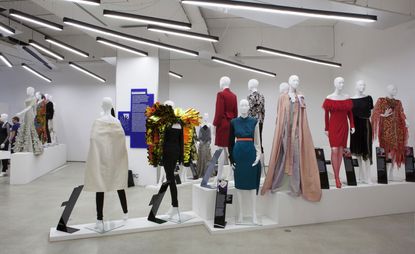
A few years ago, Hillary Clinton responded to a journalist asking about her fashion preferences with, 'Would you ask me this question if I were a man?' The journalist's answer was defensive, of course, but the reasons behind Clinton's reaction are much deeper and more interesting than it might seem. Now on show at the Design Museum, Women Fashion Power ('Not a Multiple Choice', says the title's standfirst) examines this tension with a display of garments that have helped shape the identities of strong, successful women over the ages.
It goes without saying that women's fashion has had a much stronger cultural impact throughout history than men's: corsets, trousers, and silhouettes evolving with time. In the past, it was women who were confined to the most restrictive garments, while recently it seems the tables have turned.
Today, women's fashion is loaded with cultural, social and artistic meaning – much more intrinsically than menswear. It drives powerful personalities and contributes directly to their identity. 'This exhibition is very much about the reality of dress,' says Colin McDowell, the fashion journalist who co-curated the exhibition. The show doesn't aim to define a movement, he says, but rather showcase 'how intelligent women take what they need from fashion'.
The exhibition follows two divergent themes, playing on the show's title. At one end, rooms named 'Power and Fashion' and 'Fashion and Women' display a visual history of women's clothing from Eve to the present day, with iconic garments, photographs and historical documents. The third and final room, called 'Women and Power', closes the circle, featuring 26 contemporary women and the clothes they've chosen to represent them.
The diverse group includes women from the fields of politics, culture, entertainment and society, from the singer Skin to Parisian mayor Anne Hidalgo, from art curator Julia Peyton-Jones to architect Zaha Hadid. The garments on display come from their personal closets and are significant for having played a role in their impact on the world.
Hadid also helped shape the show itself. Her interior design - along with graphics by LucienneRoberts+ - supports the work of McDowell and Design Museum curator Donna Loveday. While Hadid's structure plays a pivotal role in dividing the space almost unobtrusively, Roberts' dynamic graphics have no problem shouting with light, colour and Perspex. The exhibition's title inspired Roberts to intersect the three key words, 'women', 'fashion' and 'power', in a moving installation. It's a fitting celebration of the powers on show.
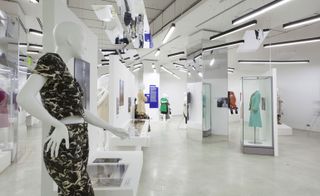
The exhibition examines the garments that have helped shape the identities of strong, successful women over the ages.

The show follows two divergent themes, playing on the show's title. At one end, rooms named 'Power and Fashion' and 'Fashion and Women' display a visual history of women's clothing from Eve to the present day, with iconic garments, photographs and historical documents.
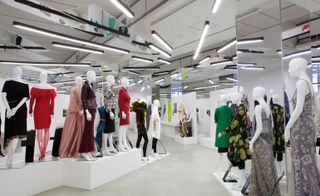
The third and final room, called 'Women and Power', closes the circle, featuring 26 contemporary women and the clothes they've chosen to represent them.
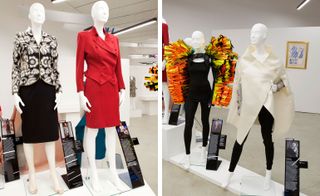
Contributions from Julia Peyton-Jones, Kirsty Wark, Skin and Zaha Hadid, who was also responsible for the exhibition design.

Graphics, meanwhile, come courtesy of design studio LucienneRoberts+. The exhibition's title inspired Roberts to intersect the three key words, 'women', 'fashion' and 'power', in a moving installation.
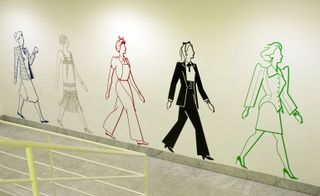
At the entrance to the exhibition is an illustration by Ben Wiseman depicting an Edwardian cyclist, a 1920s flapper, a working woman during World War II, a liberated 1960s woman in an Yves Saint Laurent 'Le Smoking' tuxedo suit and a power-suited woman of the 1980s.
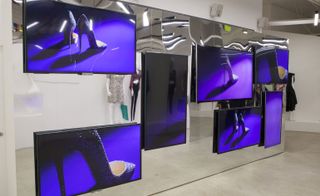
The show includes an installation of vast, colourful screens with images of statement fashion.
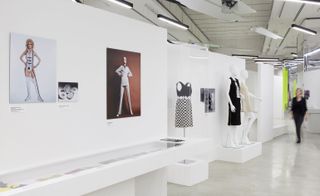
Jane Fonda and Twiggy make power poses in the 'Women and Fashion' room.

Vivienne Westwood contributed some seminal pieces from her past collections including her 'God Save the Queen' t-shirt (left) from 1977.
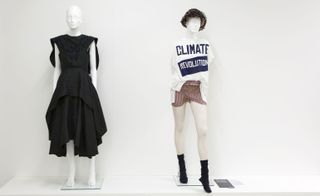
A Westwood dress with her 'Climate Revolution' t-shirt from S/S 2013.
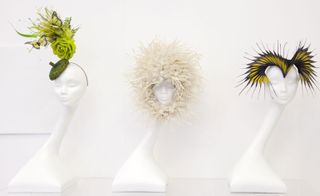
A trio of eye-catching hats on display at 'Women Fashion Power'.

Behind a Perspex screen is an example of affordable fashion from the 1960s, and a photograph from Woodstock.
ADDRESS
Design Museum
Shad Thames
London
SE1 2YD
Wallpaper* Newsletter
Receive our daily digest of inspiration, escapism and design stories from around the world direct to your inbox
Rosa Bertoli was born in Udine, Italy, and now lives in London. Since 2014, she has been the Design Editor of Wallpaper*, where she oversees design content for the print and online editions, as well as special editorial projects. Through her role at Wallpaper*, she has written extensively about all areas of design. Rosa has been speaker and moderator for various design talks and conferences including London Craft Week, Maison & Objet, The Italian Cultural Institute (London), Clippings, Zaha Hadid Design, Kartell and Frieze Art Fair. Rosa has been on judging panels for the Chart Architecture Award, the Dutch Design Awards and the DesignGuild Marks. She has written for numerous English and Italian language publications, and worked as a content and communication consultant for fashion and design brands.
-
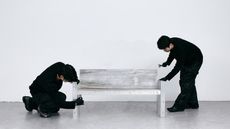 Niceworkshop explores the cycle of industrial materials at Milan Design Week
Niceworkshop explores the cycle of industrial materials at Milan Design WeekSeoul-based Niceworkshop caught the design world’s attention with its inaugural collection dedicated to the humble bolt. Now, with its first solo showing at Capsule Plaza, the studio aims to disrupt the life cycle of industrial materials with an exploration into aluminium formwork
By Laura May Todd Published
-
 The visual feast of the Sony World Photography Awards 2024 is revealed
The visual feast of the Sony World Photography Awards 2024 is revealedThe Sony World Photography Awards 2024 winners have been revealed – we celebrate the Architecture & Design category’s visual artists
By Ellie Stathaki Published
-
 Don’t Move, Improve 2024: London’s bold, bright and boutique home renovations
Don’t Move, Improve 2024: London’s bold, bright and boutique home renovationsDon’t Move, Improve 2024 reveals its shortlist, with 16 home designs competing for the top spot, to be announced in May
By Ellie Stathaki Published
-
 Inside the Design Museum exhibition celebrating 30 years of energetic, rebellious London fashion
Inside the Design Museum exhibition celebrating 30 years of energetic, rebellious London fashionAs London Fashion Week arrives, here’s our insider’s tour of ‘Rebel: 30 Years of London Fashion’ at the Design Museum, which celebrates the British Fashion Council’s career-starting Newgen scheme
By Orla Brennan Published
-
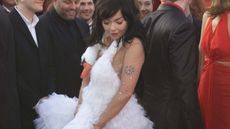 Design Museum to celebrate rebellious London fashion, including Björk’s infamous swan dress
Design Museum to celebrate rebellious London fashion, including Björk’s infamous swan dress‘Rebel: 30 Years of London Fashion’ at the Design Museum, sponsored by Alexander McQueen, will celebrate the trailblazing designers who have lived and worked in the British capital
By Jack Moss Published
-
 ENG Shanghai: Minority Report-inspired retail for the Gen Z mind
ENG Shanghai: Minority Report-inspired retail for the Gen Z mindENG Shanghai opens its second luxury fashion concept store aimed at Gen Z customers, inside the city’s TX Mall, featuring artworks by Carlos Saez, robotic arms and cyborg-like mannequins
By Laura Hawkins Last updated
-
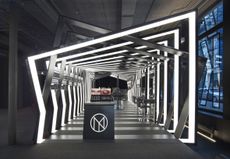 Zaha Hadid Architects designs a mobile make-up pavilion in New York City
Zaha Hadid Architects designs a mobile make-up pavilion in New York CityBy Pei-Ru Keh Last updated
-
 Glove story: we can’t keep our hands to ourselves with Zaha Hadid’s latest collaboration
Glove story: we can’t keep our hands to ourselves with Zaha Hadid’s latest collaborationBy Laura Hawkins Last updated
-
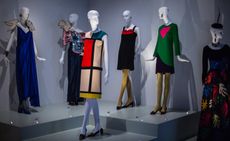 Timeless and iconic: the Bowes Museum hosts UK’s first ever Yves Saint Laurent retrospective
Timeless and iconic: the Bowes Museum hosts UK’s first ever Yves Saint Laurent retrospectiveBy Christopher Stocks Last updated